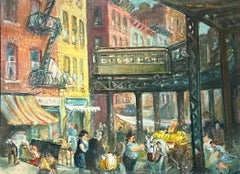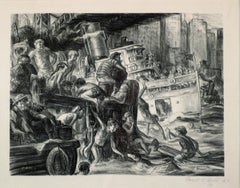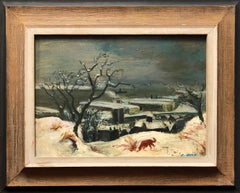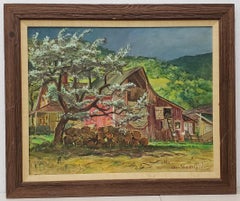Cecil Crosley Bell Art
Cecil Crosley Bell was born on July 15, 1906, in Seattle. Bell studied printmaking at the Art Institute of Chicago before moving to New York to study at the Art Students League with John Sloan. Bell remained in New York, eventually settling in Staten Island with his wife. Most of his paintings depict famous locations around New York City. Bell died in New York in 1970. Largely unknown during his lifetime, in 1973 a retrospective of his work was held at The Museum of Modern Art, New York.
1930s American Realist Cecil Crosley Bell Art
Canvas, Oil
1930s American Realist Cecil Crosley Bell Art
Oil, Board
1930s Cecil Crosley Bell Art
Lithograph
20th Century American Realist Cecil Crosley Bell Art
Drypoint
Mid-20th Century Cecil Crosley Bell Art
Ink, Watercolor
1950s American Modern Cecil Crosley Bell Art
Oil, Panel
1950s American Modern Cecil Crosley Bell Art
Oil, Wood Panel
1970s Pop Art Cecil Crosley Bell Art
Lithograph
1970s American Realist Cecil Crosley Bell Art
Canvas, Oil, Board
20th Century Surrealist Cecil Crosley Bell Art
Lithograph
18th Century Rococo Cecil Crosley Bell Art
Ink, Watercolor
1970s Pop Art Cecil Crosley Bell Art
Lithograph
2010s Pop Art Cecil Crosley Bell Art
Lithograph, Offset, Permanent Marker
2010s Other Art Style Cecil Crosley Bell Art
Lithograph
1920s American Realist Cecil Crosley Bell Art
Canvas, Oil, Cotton Canvas
1980s Expressionist Cecil Crosley Bell Art
Lithograph
1890s American Realist Cecil Crosley Bell Art
Canvas, Oil
1830s American Realist Cecil Crosley Bell Art
Engraving
1910s American Realist Cecil Crosley Bell Art
Lithograph
1940s American Realist Cecil Crosley Bell Art
Canvas, Oil
Mid-20th Century Impressionist Cecil Crosley Bell Art
Masonite, Oil
20th Century Abstract Impressionist Cecil Crosley Bell Art
Board, Oil







